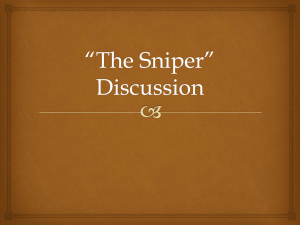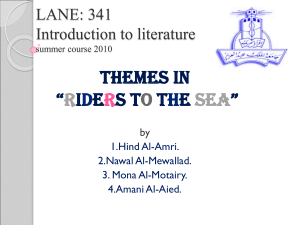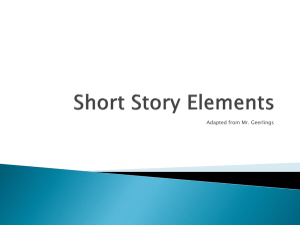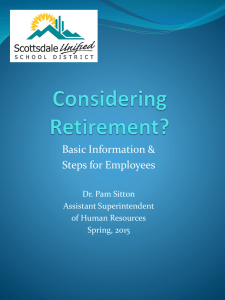dinner party notes
advertisement
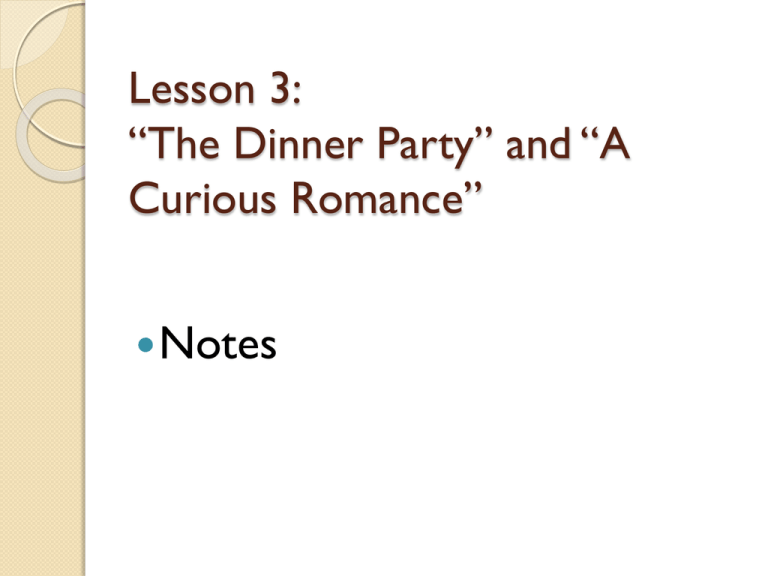
Lesson 3: “The Dinner Party” and “A Curious Romance” Notes What literary devices does and author use to help to communicate theme in a work of fiction? Irony: a literary device that uses a word or phrase to mean the exact opposite of its literal or usual meaning; incongruity between the actual result of a sequence of events and the expected result. Setting: The time and place in which a story occurs; details related to time and place affect the meaning of a text. Key Words Comparison: Finding the similarities or “sameness” of two or more things. Contrast: Finding the differences of two or more things. Key Words Theme: The statements about life and the “big ideas” that an author communicates in a work of fiction. Key Words Direct Characterization Indirect Characterization stereotypes interior monologue dialogue suspense Activity: Pair-Share for Setting What do you think is the setting communicated in this image? How does setting affect your expectations about what is happening in this image? Evidence of Literary Devices used to Communicate Theme in “The Dinner Party” 1. What is the main conflict in the story? The story has 2 intertwined conflicts: —main conflict—problem of assumptions of stereotype —secondary conflict—the threat of the cobra 2. What do you think is the climax of the plot? The climax occurs when the snake goes for the bowl of milk and the American slams the door shut. Theme in “The Dinner Party” One possible theme is that not all stereotypes are true. The thought that “all women scream during a crisis” gets proven wrong when Mrs. Wynnes remains calm during the crisis moment with the cobra. Key Words: Definitions Key Words: Fill in the blank. Irony suspense explicit evidence implicit evidence conflict proof of an idea communicated by an author 1._______________________________ that is stated directly within the text. of an idea communicated by an author 2._______________________________proof that is inferred by the reader through the connection of key details within the text. ________________________________a literary technique of creating interest and 3. intriguing the reader to wonder what will happen next; find an example in the text! problem in a story that drives the plot 4._________________________________the to a climax. something is the opposite of what is 5.__________________________________when expected; find an example in text Evidence of the Author’s use of Irony to Communicate Theme in “A Dinner Party” Best evidence: “Because it was crawling across my foot.” (30) Why is this the best evidence of irony? answer: This evidence disproves the expectation and stereotype set up in the exposition by the prejudice again women of the Colonel. Evidence of the Author’s use of suspense to communicate theme in “A Dinner Party” “he sees a strange expression come over the face of the hostess.” (29) “the boy’s eyes widen, and he quickly leaves the room.” (29) “there is only one place left—-under the table.” (29) “his first impulse is to jump back and to warn the others…”(29) “he is saying ‘two hundred and eighty” when, out of the corner of his eye, he sees the cobra emerge…” (30) “screams ring out as he jumps to slam the veranda shut” (30) also…VERB TENSE is Present tense…more immediate feeling— Archetypal Theme: Stereotypes Define in your Textual Analysis packet: Stereotype: A general _assumption_ that is made about a ___group__ of people and is applied to everyone in that group. Stereotypes are based upon prejudice. Evidence of Stereotypes in “The Dinner Party” Best evidence of stereotype: “A woman’s unfailing reaction in any crisis,” the colonel says, “is to scream.” (29) How does an author use setting to help communicate the theme? Why is it important to know the setting of a story? Answer: Understanding the setting is important because it affects the reader’s ____expectations________________________. Main Character Review Main Characters in the story: Importance within the story 1. Mrs. Wynne hostess of the party; demonstrates through her calm problem-solving of the cobra crisis that the colonel’s stereotype about women is false. American Naturalist guest at the party; elite 2. professor of nature; only person to recognize Mrs. Wynne’s problem-solving; figures out a cobra is in the room and helps solve the problem of the cobra and the stereotype. 3. colonel shows prejudice as he debates with a young girl and says that all women scream in a crisis 4. young girl defends women; courage to debate the colonel 5. servant afraid of the cobra; obeys quickly and sets out the milk 6. colonial official host of the party; How does an author use characterization to communicate theme? : The Direct Characterizaton narrator in the text states facts and description for the reader. Indirect Characterization: The reader has to infer character traits based upon key details in the text. Application of Direct and Indirect Characterization . You will use your textbook and scan the story for descriptions of characters. 2. Direct characterization is easier---the narrator states directly some details about the character. 3. Indirect characterization is like a puzzle— you have to “read between the lines” and draw conclusions about the character. How do we use Indirect Characterization to interpret theme? Look for-- 1. things the character says 2. Things that other characters say or feel about the character 3. Physical actions or facial expressions that reveal something about the character. Then figure out what these reveal about the character. Theme in “The Dinner Party”: Textual Structure Definition of theme: The overall meaning, big idea, or life insight that the author communicates in a text. How does the author structure the text and include Key Details so that you can interpret her meaning in “The Dinner Party?” Use the graphic organizer to find evidence related to the theme of this story.





